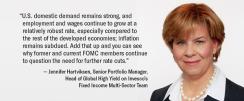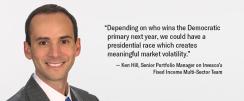Chicago Cubs legend Ernie Banks was famously passionate about the joy he derived from baseball, summed up by his mantra, “It’s a beautiful day – let’s play two.” To the team behind Invesco’s Active Multi-Sector Credit Strategy, enthusiasm runs equally deep. To them, it’s always a good time for multi-sector credit, a state of mind that has proved itself out in 2019. The strategy is specifically designed to provide high-yield-like return potential with a lower volatility profile over the full course of the credit and rate cycle. Recently, II sat down with Invesco’s Jennifer Hartviksen, Senior Portfolio Manager, Head of Global High Yield, and Ken Hill, Senior Portfolio Manager, Invesco Fixed Income Multi-Sector, to ask how the strategy fared in 2019 – and what they’re monitoring as 2020 approaches.
What occurred in markets – and outside them – in 2019 that aligned with Invesco’s Multi-Sector Credit Strategy? Or, perhaps more specifically, how did the construction of the strategy allow you to respond to events?
Ken Hill: The Fed’s signaling and ultimately delivering on its mini rate cutting cycle has benefited our Multi-Sector Credit Strategy. In the fourth quarter of 2018, we added more duration sensitive credit assets – BBs and BBBs – to our opportunistic bucket, in effect positioning for a Fed relent which ended up paying off handsomely in the first and second quarter of this year. Of late, we’ve exited most of our opportunistic BB exposure in favor of idiosyncratic positions and lower credit quality names. We’ve also participated in various portfolio hedges, such as FX options in a limited loss format that have really helped protect the portfolio from geopolitical events. The effect of this has been to help dampen the volatility of the strategy without sacrificing too much in terms of performance. I would say we’ve had almost the opposite of a perfect storm for our Multi-Sector Credit Strategy.

It’s frequently said that cycles don’t die of old age, but the one we’re in is long in the tooth. What do you anticipate in that regard in 2020?
Jennifer Hartviksen: The primary concerns going into 2020 are macroeconomic and policy issues. Is the Fed going to stop easing, or do they see something that other market participants don’t? U.S. domestic demand remains strong, and employment and wages continue to grow at a relatively robust rate, especially compared to the rest of the developed economies; inflation remains subdued. Add that up and you can see why former and current FOMC members continue to question the need for further rate cuts.
What else do you foresee as being potentially significant in 2020, and how will your multi-sector strategy remain resilient in relation to them?
Hartviksen: Ample liquidity and negative interest rates will continue to support risky assets, so we remain fully invested in emerging market and high yield debt, and underweight bank loans, floating rate notes, and investment grade. Duration is unlikely to provide the same excess returns seen in the first three quarters of this year, so our bias will be to hedge duration to preserve capital.
Hill: We think the trend of geopolitical risk driving financial markets is here to stay. If you look at global growth and central bank easing – a lot of both can be tied to or coincident with certain geopolitical tension, primarily the U.S./China trade war. Even if the U.S. and China appear to secure a mini-trade deal, we think the tensions between the two countries will remain and perhaps increase over the longer term.
Some observers are saying a long-term solution to the U.S./China trade imbroglio is unlikely at all.
Hill: That would be our house view, too. Trump opened Pandora’s box by attacking China, a country that used to be a third rail in the business community. Now it appears there is support on both sides of the aisle in Congress for a tougher stance on China, and that doesn’t seem to be going away anytime soon.

Hartviksen: The 2020 election will have the biggest impact on industry sectors, such as healthcare, where there is a significant divergence of policy philosophy between Republicans and Democrats – and among the current slate of Democratic candidates.
Hill: We have a president who’s facing impeachment, and depending on who wins the Democratic primary next year, we could have a presidential race which creates meaningful market volatility. Even now the financial markets are starting to think about that and slowly position themselves for the prospect of a Warren vs. Trump presidential race. We could also see a general election in the UK at the end of this year that might finally result in the country leaving the EU – or not. We really don’t know.
Would you say that next year’s election cycle could potentially have historical impact on volatility?
Hartviksen: It has the potential. If you remember 2016, we had the Brexit vote and Trump winning the U.S. election. Next year, if Jeremy Corbin were to win a UK election, and Elizabeth Warren were to win the U.S. presidency, you could almost have the exact opposite market response. Instead of yields shooting up and stocks doing better, you could have deals plummeting and stocks selling off. It’s a possibility.
Start a conversation about your fixed income portfolios. Learn more.
This article is for US Institutional Investor Use Only. Content was developed in November 2019. This is for informational purposes only and is not an offer to buy or sell any financial instruments. As with all investments there are associated inherent risks. This should not be considered a recommendation to purchase any investment product. The opinions expressed in this article are those of the authors and are based on current market conditions and are subject to change without notice. These opinions may differ from those of other Invesco investment professionals.
Asset allocation, diversification and low or negative correlation do not guarantee a profit or eliminate the risk of loss. Alternative products typically hold more non-traditional investments and employ more complex trading strategies. Investors considering alternatives should be aware of their unique characteristics and additional risks from the strategies they use. Forward-looking statements are not guarantees of future results. They involve risks, uncertainties and assumptions. There can be no assurance that actual results will not differ materially from expectations.
Institutional Separate Accounts and Separately Managed Accounts are offered by Invesco Advisers, Inc. and other affiliated investment advisers, which provide investment advisory services and do not sell securities. Invesco Advisers Inc. is an investment adviser; it provides investment advisory services to individual and institutional clients and does not sell securities.
NA11928






